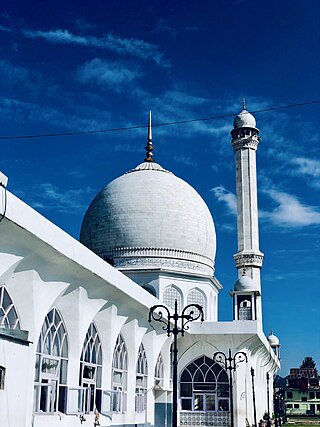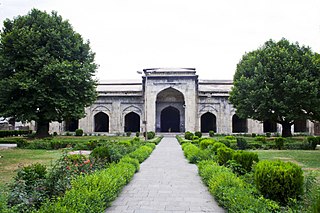
Srinagar is a city in Indian-administered Jammu and Kashmir in the disputed Kashmir region. It is the largest city and summer capital of Jammu and Kashmir, which is an Indian-administered union territory. It lies in the Kashmir Valley along the banks of the Jhelum River, and the shores of Dal Lake and Anchar Lakes, between the Hari Parbat and Shankaracharya hills. The city is known for its natural environment, various gardens, waterfronts and houseboats. It is also known for traditional Kashmiri handicrafts like the Kashmir shawl, papier-mâché, wood carving, carpet weaving, and jewel making, as well as for dried fruits. It is the second-largest metropolitan area in the Himalayas.

The Srinagar District is an administrative district of Indian-administered Jammu and Kashmir in the disputed Kashmir region. It is one of the 20 districts of Jammu and Kashmir. Situated in the centre of the Kashmir Valley, it is the second-most populous district of the union territory after Jammu District as per the 2011 national census, and is home to the summer capital city of Srinagar. Likewise, the city of Srinagar also serves as the Srinagar District's headquarters.

Dara Shikoh, also transliterated as Dara Shukoh, was the eldest son and heir-apparent of the Mughal emperor Shah Jahan. Dara was designated with the title Padshahzada-i-Buzurg Martaba and was favoured as a successor by his father and his elder sister, Princess Jahanara Begum. He had been given the title of 'Shah-e-Buland Iqbal' by Shah Jahan. In the war of succession which ensued after Shah Jahan's illness in 1657, Dara was defeated by his younger brother Prince Muhiuddin. He was executed in 1659 on Aurangzeb's orders in a bitter struggle for the imperial throne.
Nowhatta, known as Navyut in Kashmiri, is a town of historical importance situated at a distance of 5 km from Lal Chowk, Srinagar in Jammu and Kashmir, India. Nowhatta is famous because of Historical Mosque known as Jamia Masjid. Nowhatta area has eighteen sub-communities Mohalla. The place is also notable for high rate of stone pelting incidents in Kashmir. Each week after Friday prayers, people stage their protest against Indian rule which most of the times results in stone pelting incidents in the area.

The Shah Mir dynasty or the House of Shah Mir, was a Kashmiri dynasty that ruled the Kashmir Sultanate in the Indian subcontinent. The dynasty is named after its founder, Shah Mir.

Mirwaiz Mohammad Umar Farooq is the 14th Mirwaiz of Kashmir. He is a Kashmiri separatist political leader. He is also an Islamic religious cleric of Kashmir Valley.

The Hazratbal Shrine, popularly called Dargah Sharif, is a Sufi dargah and mosque, located in Hazratbal locality of Srinagar, in the union territory of Jammu and Kashmir, India. The site contains a relic, Moi-e-Muqqadas, believed to be the hair of the Islamic prophet Muhammad. It is situated on the northern bank of the Dal Lake in Srinagar, and is considered to be Kashmir's holiest Muslim shrine.

The Jamia Masjid is a Friday mosque, located at Nowhatta in the Old City of Srinagar, in the union territory of Jammu and Kashmir, India. The mosque was commissioned by Sultan Sikandar in 1394 CE and completed in 1402 CE, at the behest of Mir Mohammad Hamadani, son of Mir Sayyid Ali Hamadani, and is regarded as one of the most important mosques in Kashmir. The mosque is located in a central zone in the religio-political life in Srinagar. Thronged by Muslims every Friday, it is a prime tourist attraction of the city.

Bijbehara (Urdu pronunciation:[biːd͡ʒbɪɦɑːɽɑː], known as Vejibror in Kashmiri, is a town and a notified area committee in Anantnag district of the Indian administered union territory of Jammu and Kashmir. It is located on NH 44, and jehlum bank. Bijbehara town is also known as "Town of Chinars" because of a number of Chinars there especially two Chinar gardens. Bijbehara is the home to oldest chinar tree in the region. The town is situated about 45 km from the summer capital of union territory of Jammu and Kashmir, Srinagar.

Chashme Shahi, Chashma i Shahi, or Cheshma Shahi, also called Chashma Shahi or Cheshma Shahi, is one of the Mughal gardens built in 1632 AD around a spring by Ali Mardan Khan, a governor of Mughal emperor Shah Jahan as per the orders of the Emperor, as a gift for his eldest son Prince Dara Shikoh. The garden is located in the Zabarwan Range, near Raj Bhawan overlooking Dal Lake in Srinagar, Jammu and Kashmir, India.

Pari Mahal or Peer Mahal, also known as The Palace of Fairies a beautiful garden, It is the seven-terraced Mughal garden located at the top of Zabarwan mountain range, overlooking the city of Srinagar and the south-west of Dal Lake in the Indian union territory of Jammu and Kashmir. It is an example of Islamic architecture and patronage of art during the reign of the then Mughal Emperor Shah Jahan, featuring arched doorways, terraced gardens, and intricate water channels.

Persian Inscriptions on Indian Monuments is a book written in Persian by Dr Ali Asghar Hekmat E Shirazi and published in 1956 and 1958 and 2013. New edition contains the Persian texts of more than 200 epigraphical inscriptions found on historical monuments in India, many of which are currently listed as national heritage sites or registered as UNESCO world heritage, published in Persian; an English edition is also being printed.

The Madin Sahib Mosque, also known as the Madeen Sahab Masjid and the Madin Saeb Masjid, is a former mosque, now in partial ruins, located in the Zadibal area of Srinagar, in the union territory of Jammu and Kashmir, India. The mosque is listed as a State-protected monument.

The Aali Mosque, also known as the Ali Mosque and the Great Jamia Masjid at Eidgah Serrnagar, is a mosque located in Srinagar, in the union territory of Jammu and Kashmir, India. The mosque was built in 1395 CE by Sultan Ali Shah, the elder brother of Sultan Zain al-Abidin (Budshah), and named the mosque after himsefl. It is also believed to have been constructed in 1471 CE during the reign of Shamiri King Sultan Hassan Shah and named after Sayyid Ali Hamadani (Shah Hamdan).
Downtown, popularly known as Shahar-e-Khaas, is the largest and the most densely populated area of the city of Srinagar in the union territory of Jammu and Kashmir, India. The area is mostly located on the banks of Jhelum river about five km (3.1 mi) from city center. The area is considered as the core point in the city as the first inhabitants of the Srinagar lived there. In general, the whole area to the north of city centre Lal Chowk is considered a part of downtown although some areas hold high significance. The Jamia Masjid, Srinagar and many other shrines are located here, which makes it the central spiritual, religious, political and moral center of whole Kashmir.
Anwar Shah Shopiani, also known by the honorary title Mawlawi Anwar Shah Shopiani, was a Kashmiri Islamic preacher, scholar and poet. He was the founder of Ahl-i Hadith movement in Jammu and Kashmir, and is also credited for establishing the Ahl Al-Hadith Masjid at Zaldagar, the first Ahl-i Hadith mosque of the Kashmir Valley built in 1897. He also served as Imam at Jamiat-e-Ahle Hadith, J&K in Zaldagar, Srinagar.

The Khanqah-e-Moula Kashmiri: خانقاہِ معلیٰ), also known as Shah-e-Hamadan Masjid and Khanqah, is a Sunni mosque located in the Old City of Srinagar in Jammu and Kashmir, India. Situated on the right bank of the river Jhelum between the Fateh Kadal and Zaina Kadal bridges, it was built in 1395 CE, commissioned by Sultan Sikendar in memory of Mir Sayyid Ali Hamadani. It is held to be the first Khanqah—mosques associated with specific saints—in the Kashmir valley. It is one of the best examples of Kashmiri wooden architecture, and is decorated with papier mache. The mosque structure is a Monument of National Importance.

The Pathar Mosque, known locally as Naev Masheed, is a Mughal era stone Shi’a mosque located in the old city of Srinagar, in the union territory of Jammu and Kashmir, India. It is located on the left bank of the River Jhelum, just opposite the shrine of Khanqah-e-Moula. The mosque structure is a Monument of National Importance.

The following outline is provided as an overview of and topical guide to Jammu and Kashmir:
The Eidgah Shah-i-Hamdan is an historic eidgah (Musalla), located in Srinagar, in the union territory of Jammu and Kashmir, India. The Srinagar eidgah, named in honour of Mir Sayyid Ali Hamadani, is an open space on the banks of the Jhelum River where Muslims gather for Eid prayers on Eid al-Fitr and Eid al-Adha.



















